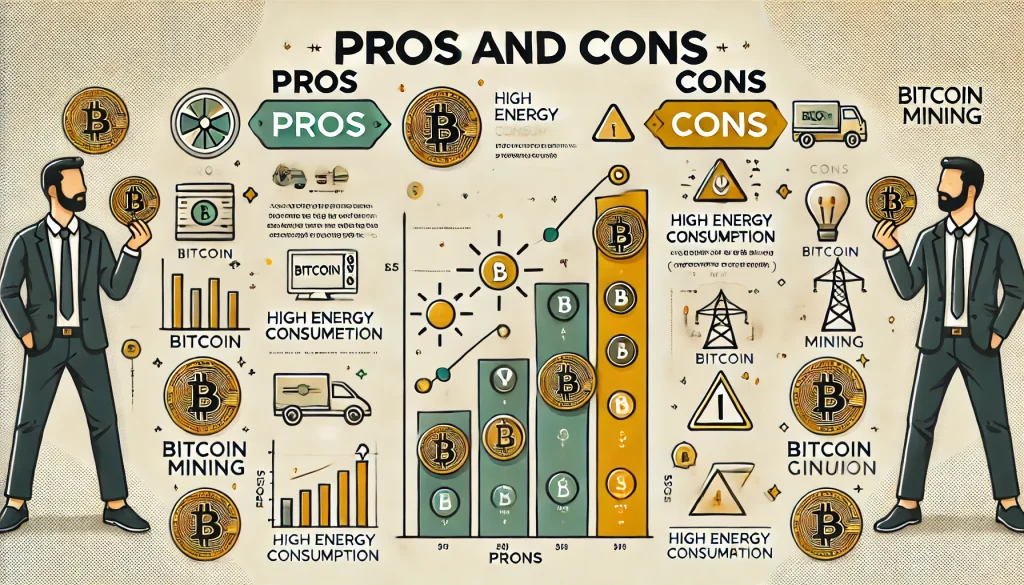Introduction

Bitcoin mining has long been a cornerstone of the cryptocurrency ecosystem, attracting tech enthusiasts and investors alike. As we enter 2024, the landscape of Bitcoin mining is evolving, with new challenges and opportunities shaping its profitability. In this review, we focus on Bitcoin mining in 2024, exploring the possibilities, potential returns, and factors that may influence your decision to jump into mining or stay invested. Whether you’re a seasoned miner or just starting out, it’s important to understand the current state of Bitcoin mining.
Overview
In 2024, Bitcoin mining is still a complex and exciting process, mostly done with high-performance mining rigs and vast mining fields. The increasing difficulty of mining, coupled with fluctuations in the price of Bitcoin, is having a significant impact on profitability. Key factors such as energy costs, hardware efficiency, and network hashrate continue to play a significant role. This year has also seen a surge in discussions about the environmental impact of mining, as well as policy changes that could impact mining operations globally. Understanding these dynamics is essential for anyone involved in or interested in Bitcoin mining.
Pros and cons

Pros
- Potential for high returns: Bitcoin’s value continues to be very popular, offering the potential to provide miners with significant returns, especially when the price spikes.
- Technological advancements: Mining hardware has become more efficient, reducing operating costs and energy consumption per hash.
- Decentralization: Bitcoin mining contributes to the decentralization of the cryptocurrency network, making it more secure from potential attacks.
Cons
- High operating costs: Energy consumption and maintenance costs remain a big issue, and small-scale mining is often unprofitable.
- Environmental impact: The carbon footprint of Bitcoin mining is increasingly being scrutinized, which could lead to potential regulatory and tax pressures.
- Market volatility: The profitability of mining is closely tied to the price of bitcoin, which is notoriously volatile.Pros and cons
Deep dive analytics

Mining hardware efficiency
The evolution of mining hardware has been shifting from CPUs to GPUs and now to application-specific integrated circuits (ASICs), which will dominate the market in 2024. The latest models boast higher hash rates and lower energy consumption, but come at a significant upfront cost. Mining rigs like the Antminer S19 Pro+ offer impressive performance but require a significant capital investment.
Energy consumption
Energy consumption remains a controversial issue in Bitcoin mining. The energy-intensive nature of the mining process has led to criticism of its impact on the environment. Mining can still be profitable in areas where electricity is cheap, such as hydroelectric areas, but miners in areas with higher energy costs are facing shrinking margins.
Regulatory environment
2024 is a year of increased government attention to the environmental impact of Bitcoin mining. New regulations and potential carbon taxes are being discussed, which could have a greater impact on profitability. This is especially relevant in countries like China and the United States, where large-scale mining is widespread.
Market conditions
The profitability of Bitcoin mining is highly sensitive to the price of Bitcoin. Despite the recent bear market, Bitcoin’s resilience and potential for future appreciation has kept miners engaged in mining. However, the breakeven point is high, and Bitcoin must remain at or above a certain price level for miners to remain profitable.
Compare
Comparing Bitcoin mining in 2024 to previous years reveals several key differences. Increased difficulty has led to a decrease in the number of successful mining operations, especially for small miners, while large mining operations with access to cheaper energy and more advanced hardware have been able to remain profitable. Compared to other cryptocurrencies like Ethereum, which has switched to a Proof of Stake (PoS) model, Bitcoin’s Proof of Work (PoW) is still energy-intensive, but critical for security.
Compare mining rigs
| Mining League Model | Hash speed (TH/s) | Energy consumption (W) | Price ($) |
|---|---|---|---|
| Antminer S19 Pro+ | 110 | 3250 | 4,500 |
| Whatsminer M30S++ | 112 | 3472 | 4,200 |
| Bitmain S17+ | 73 | 2920 | 2,900 |
Conclusion
Bitcoin mining in 2024 will be a double-edged sword, with potential rewards for those who can solve increasingly complex and difficult problems. Environmental and regulatory pressures are growing, but advances in mining technology and the potential for Bitcoin’s value to increase will keep the industry going. For investors, large-scale operations with efficient hardware and low energy costs appear to be the most realistic.
Evaluation
4/5 – Despite the challenges, Bitcoin mining is still a profitable business for those who can optimize their operations.
FAQ
Will Bitcoin mining still be profitable in 2024?
Profitability depends on many factors, including energy costs, hardware efficiency, and the market price of Bitcoin. Larger mining operations tend to be more profitable due to economies of scale.
What is the environmental impact of Bitcoin mining?
Bitcoin mining leaves a significant carbon footprint due to its high energy consumption, which has led to concerns and potential regulatory action.
What is the best hardware for Bitcoin mining in 2024?
In 2024, ASIC miners, especially models like the Antminer S19 Pro+, are expected to be the most efficient and widely used.
See also
- B2BinPay. (2024). Is crypto mining farm still profitable in 2024? B2BinPay. Retrieved from https://b2binpay.com/en/crypto-mining-farm-still-profitable-2024/
- Compass Mining. (2024). Bitcoin mining industry report: July 2024 monthly operational updates. Compass Mining. Retrieved from https://compassmining.io/education/bitcoin-mining-industry-report-july-2024-monthly-operational-updates/
- International Monetary Fund. (2024, August 15). Carbon emissions from AI and crypto are surging, and tax policy can help. International Monetary Fund. Retrieved from https://www.imf.org/en/Blogs/Articles/2024/08/15/carbon-emissions-from-ai-and-crypto-are-surging-and-tax-policy-can-help
- Encyclopædia Britannica. (n.d.). What is crypto mining? Encyclopædia Britannica. https://www.britannica.com/money/what-is-crypto-mining
- EZ Blockchain. (n.d.). Pros and cons of crypto mining for humanity. EZ Blockchain . Retrieved from https://ezblockchain.net/article/pros-and-cons-of-crypto-mining-for-humanity/
